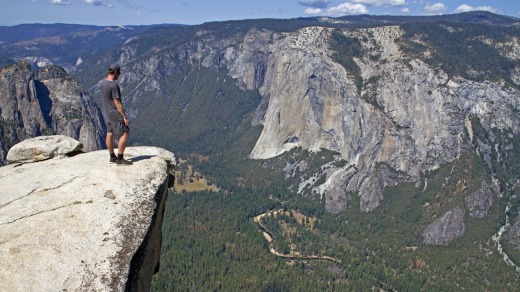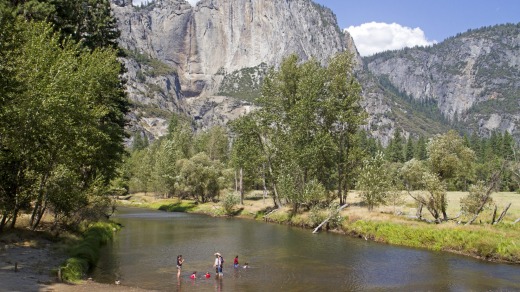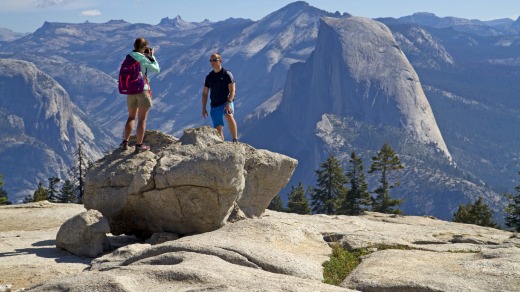Yosemite Falls is the tallest waterfall in North America, and is a powerful presence in Yosemite Valley. From winter ice to spring flood to autumn dryness, this magnificent waterfall is a dynamic force of nature. Video: US National Park Service.
At Yosemite Falls, nothing is falling. It is summer's end, and I'm standing at the base of the highest tier of the tallest waterfall in North America. A bare rock wall stares down at me. It's like looking at an X-ray of the land.
I hike on, zigzagging endlessly through a break in the cliffs towards the rim of the Yosemite Valley. The sun's heat radiates from the cliffs, turning the trail into a solarium on foot, and the sound of the wind is all but replicating the sound of the absent water.
As I crest the rim, more than 700 metres above the valley floor where I set out, I stand literally face to face with nature. The bare, pale granite faces of Half Dome, North Dome stare back at me as the valley's other mighty cliffs fall away into the valley far below.

It's a view that has long tempted people to extremes, with some of the most incredible adventure feats of the last century taking place around the rim of Yosemite Valley. But Yosemite National Park is a place that also rewards even the most gentle of exploration.
To reach the top of the 739-metre-high Yosemite Falls, I've hiked for two hours – a single afternoon of work for one of the best mountain views imaginable – but there are even easier ways to reach the valley rim.
The next morning I'm heading towards Glacier Point, on the valley's opposite rim, driving towards a couple of the finest and most easily accessed viewpoints in the park.

The drive from Yosemite Valley passes beneath El Capitan, the great granite monolith that guards the valley's entrance. Among rock climbers, the Nose of El Capitan is arguably the most famous chunk of rock on Earth.
Once thought impossible to climb, it took a trio of climbers 47 days to complete the first ascent of the Nose in 1958. In 2012, it was scaled in less than 2½ hours.
Roadside pullouts and meadows in the valley provide an armchair view of the Nose, and it's not unusual to find crowds of binoculars scanning for climbers. This morning I watch as two helmeted dots grind their way up its relentless 900-metre-high wall. From the valley floor, they appear so high above, but soon I will be looking down on them.

From near Glacier Point, a hiking trail wishbones to Sentinel Dome in one direction and Taft Point in the other. Combine the two and it's just seven kilometres of easy walking for two very different but spectacular images of Yosemite.
I begin along the trail to Sentinel Dome, a great bulb of granite rising from the southern rim of the Yosemite Valley. In a direct line, it's less than three kilometres from Yosemite Village, but so convoluted is the landscape it's taken an hour to drive to the trail car park.
The trail to Sentinel Dome is set back from the cliffs, as if reluctant to reveal its views until the very end. A few metres below the trail, a bear cub forages through the scrub, content to ignore the hikers above, at least until a crowd gathers.
Sentinel Dome seems to rise like a granite bubble from the plateau, and it's a steep but short final haul to its round summit. From its surface of broken and flaked rock, ancient trees stand petrified, and suddenly Yosemite National Park is laid out like a relief map around me.
The skyline contains more domes than a Catholic city. Most prominent among them is Half Dome, its abrupt, disrupted shape keeling over as if about to topple into the Yosemite Valley.
From Yosemite Valley, Half Dome is the figure that dominates everything. Even on Sentinel Dome I stand more than 200 metres below the summit of Half Dome, yet somehow the view is contorted, creating the sensation that I'm looking down onto it.
The second arm of the hiking trail heads to the cliffs at Taft Point, from where it feels as though Yosemite Valley has been scooped out from right beneath my feet.
Here the cliffs simply disappear, plunging 1000 metres into a black abyss of shadow and then the valley. El Capitan looks like a beach pebble below. It's a scene reminiscent of ledges such as Pulpit Rock over Norwegian fiords, with just one small guardrail at the very prow of the cliffs.
Away from the guardrail, the opportunities to scare yourself silly are endless. Cut into the cliff top, like the stripes of a thylacine, are a series of fissures – deep, dark slices through the rock that peer down into a frightening amount of air – while most of the cliff is unfenced.
People crawl on hands and knees to the cliff edge, then crawl back, their faces a different colour by the time they return. I hear so many calls of "oh, my God", it's like a perpetual echo.
There's a palpable air of danger that still isn't enough for some. People have walked tightropes above the valley, without safety harnesses, from Taft Point. In May 2015, climbing great Dean Potter was one of two men killed in a wingsuit BASE jump from this very point. I step back from the edge; I'm returning to the valley by safer means.
The most dangerous thing in the valley is probably the snarl of traffic. Yosemite is the third-busiest national park in the USA, with almost four million visitors a year, and crossing the road here can be an extreme sport of its own.
But you can also now roll gently through the valley on a bicycle. Around 20 kilometres of bike paths meander through the Yosemite Valley, with fixed-gear cruiser-style bikes for hire at Yosemite Lodge at the Falls. The valley floor is as flat as the cliffs are sheer and, as I pedal out in a small peloton of bikes, deer graze deep in the shadows, hiding from the heat of the day.
The bike paths crisscross through the valley, veering close to the Merced River at times, crossing meadows and running beside the road. Unlike the cars, I can stop where I please. I pull up at the banks of the Merced River to dip my feet, and halt on the bridges that span it to take in the views. Upstream, the flat face of Half Dome rises above the cottonwood and pine trees along the bank, looking now like the wave of a tsunami about to break over me.
Yosemite isn't just a place of big cliffs, however; it's also a place of big trees. The national park contains three groves of giant sequoias, the massive trees that are considered the world's largest living organisms.
Giant sequoias are endemic to the western slopes of the Sierra Nevada Mountains and Yosemite's biggest collection of the trees is the Mariposa Grove in the park's far south. It's closed to visitors until 2017 as roads are ripped up and converted into hiking trails.
Instead I head to the Tuolumne Grove, where more than 20 mature giant sequoias are found on another easy walk. From the car park, a wide walking trail flows down the hillside, where young sequoias stand like stakes in the slopes.
As the trail bottoms out, a couple of wide, tall, impressive sequoias stand almost in reach of the trail, the redness of their bark providing an outback-like contrast against the blue sky. The fallen sequoias – leviathans tumbled to earth – are just as impressive.
I walk on as the trail circuits through this land of giants. Dust blows from the dry slopes and soon there's a larger figure ahead of me on the path than usual – another bear cub strolling towards me like an ordinary tourist. Am I being stalked by cute black mammals?
The golden rule in bear country is to never approach a cub – where's the mother, after all? – but what if it approaches you? I stop but it keeps coming, looking to have as much malicious intent as a teddy bear.
It comes to within a few metres, looks at me, sniffs and turns away up the hill, pulling at lichens from fallen branches as it wanders. It seems as content as I've been to just plod through Yosemite.
nps.gov/yose
VisitTheUSA.com.au
Qantas now flies direct to San Francisco from Sydney and Melbourne. It's a four-hour drive from San Francisco to the Yosemite Valley. Extranomical Tours runs single and multi-day trips to Yosemite from San Francisco. See www.extranomical.com.
Yosemite Valley has a range of accommodation, from camping to the beautiful stone lodge of the Ahwahnee Hotel. To escape the hordes, or if the park is booked out, Yosemite Bug Rustic Mountain Resort is about 40 kilometres from the valley and has a range of quirky rooms and a great little cafe using ingredients from the resort garden. See www.yosemitebug.com, www.yosemitepark.com/the-ahwahnee.aspx.
Even if you don't want to climb to the top of North America's highest waterfall, you can take an easy paved trail to the very base of the falls.
Good springtime walk to this lake directly beneath Half Dome. Calm conditions bring out the mirror effect.
WAPAMA FALLS
Escape the crowds to discover one of Yosemite's most powerful but little-visited waterfalls.
Stride out for a few pretty easy hours to arguably the finest viewpoint along the rim of the Yosemite Valley – an in-your-face view of Half Dome.
Popular day hike from Tuolumne Meadows to a pair of lakes at the foot of sharp-tipped Cathedral Peak. Bring your swimming cozzie.
See also: 20 things that will shock first-time visitors to the US